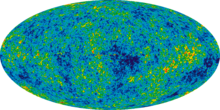- Multi-object APO Radial Velocity Exoplanet Large-area Survey
-
Physical cosmology 
Universe · Big Bang
Age of the universe
Timeline of the Big Bang
Ultimate fate of the universeEarly universeExpanding universeComponentsThe Multi-object APO Radial Velocity Exoplanet Large-area Survey (MARVELS) is a ground-based Doppler survey of 11,000 of the brightest stars.[1] The project will use the SDSS telescope and new multi-object Doppler instruments to monitor radial velocities.[1] It is one of four astronomical surveys conducted by SDSS-III, part of the Sloan Digital Sky Survey (SDSS).
The main goal of the project is to generate a large-scale, statistically well-defined sample of giant planets. It will search for gaseous planets that have orbital periods ranging from hours to 2 years, and are between 0.5 and 10 Jupiter masses. A total of 11,000 stars will be analyzed with 25-35 observations per star over an 18 month period. It is expected to detect between 150 and 200 new exoplanets, and will be able to study rare systems, such as planets with extreme eccentricity, and objects in the "brown dwarf desert".[1][2]
The collected data will be used as a statistical sample for the theoretical comparison and discovery of rare systems.[3]
The project started in the fall of 2008, and will continue until spring 2014.[1][4]
See also
The other components of SDSS-III are:
- Apache Point Observatory Galactic Evolution Experiment (APOGEE)
- Baryon Oscillation Spectroscopic Survey (BOSS)
- Sloan Extension for Galactic Understanding and Exploration 2 (SEGUE-2)
References
- ^ a b c d "Sdss-Iii". Sdss3.org. http://www.sdss3.org/surveys/marvels.php. Retrieved 2011-08-14.
- ^ Publicado por Fran Sevilla. "Carnival of Space #192: Exoplanet discovery and characterization". Vega 0.0. http://www.vega00.com/2011/04/carnival-of-space-192-exoplanet.html. Retrieved 2011-08-14.
- ^ "The Multi-Object APO Radial-Velocity Exoplanet Large-area Survey (MARVELS)". aspbooks.org. http://www.aspbooks.org/a/volumes/article_details/?paper_id=29259. Retrieved 2011-08-14.
- ^ Matt Rings (2011-01-23). "Collaboration results in largest-ever image of the night-time sky". Gizmag.com. http://www.gizmag.com/terapixel-color-digital-image-of-sky-released-by-sdss/17647/. Retrieved 2011-08-14.
External links
- Project homepage
- Detailed information: SDSS-III: Massive Spectroscopic Surveys of the Distant Universe, the Milky Way Galaxy, and Extra-Solar Planetary Systems - January 8, 2008 - PDF
- Information on target selection
Exoplanets search projects 
Ground-based - AAPS
- California and Carnegie Planet Search
- HAT
- HARPS, part of the Geneva Extrasolar Planet Search
- MEarth Project
- MOA
- OGLE
- Magellan Planet Search Program
- SuperWASP
- TrES
- XO Telescope
- EAPSNet
- High Resolution Echelle Spectrometer (HIRES)
- MARVELS
- MUSCA
- Microlensing Follow-Up Network (MicroFUN)
- NASA-UC Eta-Earth
- PHASES
- PlanetPol
- PARAS
- Subaru telescope, using the High-Contrast Coronographic Imager for Adaptive Optics (HiCIAO)
- Systemic, an amateur search project
- ZIMPOL/CHEOPS, based at the VLT
Space missions CurrentPlanned- PEGASE (est. 2010-2012)
- TESS (est. 2013-2014)
- PLATO (est. 2017)
- New Worlds (est. 2020)
- EChO (est. 2022)
Other status- See also:
- List of extrasolar planets
- Discoveries of extrasolar planets
- Unconfirmed exoplanets
- Detection methods
Astronomy Main articles Methods Cultural astronomy Selected notable optical telescopes Major subfields of astronomy and astrophysics Astrobiology · Astrochemistry · Astrodynamics · Astrometry · Astrophysics · Cosmochemistry · Cosmology · Extragalactic astronomy · Galactic astronomy · Physical cosmology · Planetary geology · Planetary science · Solar astronomy · Stellar astronomy
Categories:- Astronomical surveys
- Observational astronomy
- Astronomy stubs
Wikimedia Foundation. 2010.

